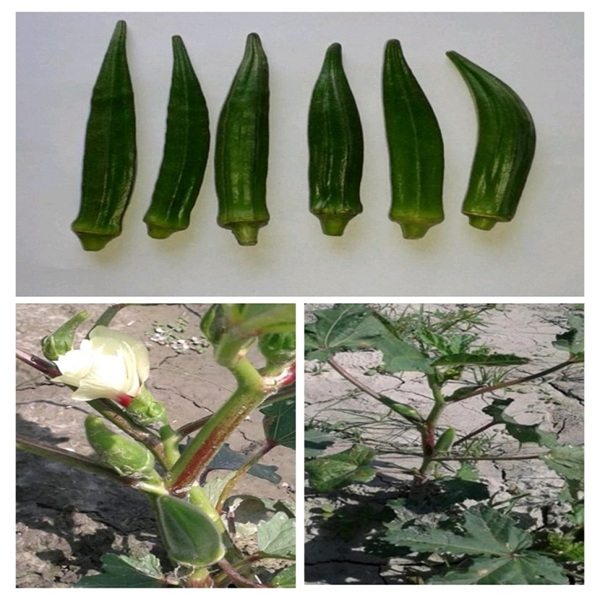Impact of foliar application of micronutrients on growth, yield, fruit quality characteristics and profitability in okra (Abelmoschus esculentus) cv. Ridhi
DOI:
https://doi.org/10.14719/pst.5424Keywords:
chlorophyll, crude protein, dry matter, economics, quality parameters, vitamin CAbstract
Okra (Abelmoschus esculentus) is a significant warm-season vegetable crop, renowned for its tender and nutritious fruits that are abundant in vitamins, minerals and dietary fibre. It is widely grown in tropical and subtropical regions because of its adaptability and economic importance. Despite its potential, it remains difficult to achieve higher productivity and quality due to suboptimal nutrient management practices. A field experiment was conducted at the experimental farm, School of Agriculture Sanjeev Agrawal Global Educational University, Bhopal during spring-summer season of 2024. The experiment was conducted in a Randomized Complete Block Design (RCBD) with 14 treatment combinations with three replications. Foliar applications of various micronutrients (B, Zn, Cu, Fe and Mn) were applied at 30 and 45 days after sowing during the evening hours. The foliar application of various micronutrients was found to enhance the growth, yield, fruit quality and financial viability of okra. The findings revealed that the highest values for plant height (135.39 cm), leaf area (4377.92 cm2), leaf area index (3.86), specific leaf weight (9.85 mg/cm2), total leaf chlorophyll (1.88 mg g- 1), total fruit chlorophyll (0.84 mg g- 1), dry matter (12.16 %), crude protein (10.29%), vitamin C (13.65 mg/100g), fruit length (10.30 cm), fruit diameter (1.42 cm), average fruit weight (9.33 g), fruit weight/plant (232.61g), number of fruits/plant (22.05) and fruit yield (172.84 q/ha) were achieved with the foliar application of treatment T14. However, in term of economics the treatment T14 documented maximum gross return (54, 5310.20) and net return (44, 5143.59) and B: C ratio of (4.44). In conclusion, the study revealed that the foliar application of micronutrients, mostly treatment T14, significantly improved the growth, yield, quality and profitability of okra cultivation. This underscores the significance of balancing micronutrient management for ensuring sustainable and economically viable crop production. The purpose of this study is to determine the most effective nutrient management strategy for optimizing okra cultivation by assessing the impact of different micronutrient treatments on plant growth, yield, quality and financial performance.
Downloads
References
Tindall HD. Vegetables in the Tropics. Houndmills Hampshire: Macmillan Education Ltd; 1983. p. 553.
Lamont WJ. Okra - a versatile vegetable crop. Hortic Technol. 1999; 9:179-184. https://doi.org/10.21273/horttech.9.2.179
Singh P, Chauhan V, Tiwari BK, Chauhan SS, Simon S, Bilal S, Abidi AB. An overview on okra (Abelmoschus esculentus L.) and its importance as a nutritive vegetable in the world. Int J Pharm Biol Sci. 2014; 4:227-233.
Dubey P, Mishra S. A review on: Diabetes and okra (Abelmoschus esculentus). J Med Plants Stud. 2017; 5:23-26.
Liu Y, Qi J, Luo J, Qin W, Luo Q, Zhang Q, Chen D, Chen H. Okra in food field: nutritional value, health benefits and effects of processing methods on quality. Food Rev Int. 2021; 37:67-90. https://doi.org/10.1080/87559129.2019.1695833
Javeed I, Narayan S, Hussain K, Khan FA, Rahman R, Akhter A, Indrabi SA, Sultan A, Rashid M. Effect of foliar application of micronutrients on fruit yield, quality and profitability of okra (Abelmoschus esculentus L.). SKUAST J Res. 2023; 25(3):486-492. https://doi.org/10.5958/2349-297X.2023.00045.4
Othmani A, Ayed S, Bezzin O, Farooq M, AyedSlama O, Slim-Amara H, Ben Younes M. Effect of silicon supply methods on durum wheat (Triticum durum Desf.) response to drought stress. Silicon. 2021; 13:3047-3057. https://doi.org/10.1007/s12633-020-00639-3
Mostafijur MR, Shila A, Kawsar H, Rayhan A, Ishrat KA, Sabia K, Nuruzzaman M. Foliar application of micronutrients promotes growth and yield-related attributes of okra (Abelmoschus esculentus L.) in a slightly salinized area. Trop Subtrop Agroecosys. 2024;27 No. 016.
Polara KB, Ponkia HP, Sakarvadia HL, Vekaria LC, Babariya NB. Effect of multi micronutrient fertilizers on yield and micronutrient uptake by okra (Abelmoschus esculentus L.) grown on medium black calcareous soils of the Saurashtra region of Gujarat. Int J Pure Appl Biosci. 2017; 5(6):258-264.
Arya P, Anitha S, Meera V, Menon PS, Bhindhu, Antony S. Foliar application of micronutrients on growth and yield of okra under different irrigated conditions. J Trop Agric. 2021; 59(1):76-82.
Domingos CDS, Besen MR, Esper Neto M, Costa EJO, Scapim CA, Inoue TT, Braccini AL. 2021. Can calcium and boron leaf application increase soybean yield and seed quality. Acta Agri Scandinavica, Section B-Soil & Plant Sci. 2021; 71:171-181. https://doi.org/10.1080/09064710.2020.1869818
Narayan S, Javeed I, Hussain K, Khan FA, Mir SA, Bangroo SA, Malik AA. Response of okra (Abelmoschus esculentus) to foliar application of micronutrients. Indian J Agric Sci. 2021; 91 (5): 749–52. https://doi.org/10.56093/ijas.v91i5.113095
Umair HM, Aamer M, Umer MC, Haiying T, Babar S, Lorenzo B, Nawaz M. The critical role of zinc in plants facing the drought stress. Agriculture, 2020; 9:396. https://doi.org/10.3390/agriculture10090396
Riaz M, Yan L, Wu X, Hussain S, Aziz O, Jiang C. Boron increases root elongation by reducing aluminum induced disorganized distribution of HG epitopes and alterations in subcellular cell wall structure of trifoliate orange roots. Ecotox Env Safety, 2018; 165:202-210. https://doi.org/10.1016/j.ecoenv.2018.09.004
Chandni V Mori, JR Vadodaria, GS Patel, Mukesh Kumar and DM Thakor. Effect of different micronutrients and stage of their application on growth of cauliflower (Brassica oleracea var. botrytis). Int. J Chem Stud. 2020; 8(3): 2579-2582. https://doi.org/10.22271/chemi.2020.v8.i3ak.9600
Yadav PK, Singh A, Agrawal SB. An overview on management of micronutrients deficiency in plants through biofortification. In: K, Mishra, P.K, Tandon, S, Srivastava ed. A solution of hidden hunger. Sustainable solutions for elemental deficiency and excess in crop plants, Singapore, Springer, 2020; pp. 183- 208. https://doi.org/10.1007/978-981-15- 8636-1_8
Haleema B, Rab A, Hussain SA. Effect of calcium, boron and zinc foliar application on growth and fruit production of tomato. Sarhad J Agric. 2018; 34:19-30. https://dx.doi.org/10.17582/journal.sja/2018/ 34.1.19.30
Fageria NK, Filho MPB, Moreira A, Guimaraes CM. Foliar fertilization of crop plants. J Plant Nutri. 2009; 32(6): 1044-1064. http://dx.doi.org/10.1080/01904160902872826
Khan FA, Banday FA, Narayan S, Khan FU, Bhat SA. Use of models as a non-destructive method for leaf area estimation in horticultural crops. IRA-Int. J. Applied Sci. 2016;4(1), 162-180. https://dx.doi.org/10.21013/jas.v4.n1.p19
Jayaraman J. Laboratory manual in biochemistry. Willey Eastern Pvt Ltd. 1981.
Tandon HLS. Methods of analysis of soils, plants, water and fertilizers. Fertilizer development and consultant organization, New Delhi. 1993.
AOAC. Official Method of Analysis: Association of Analytical Chemists. 19th Edition, Washington DC. 2012, 121-130.
Gomez KA, Gomez AA. Statistical Procedures for the Agricultural Research (2nd Edn.). John Willey and Sons, New York, USA 1984; pp. 28-92.
Mehraj H, Taufique T, Mandal MSH, Sikdar RK, Jamal Uddin, AFM. Foliar feeding of micronutrient mixture on growth and yield of okra (Abelmoschus esculantus). American-Eurasian J Agr Env Sci. 2015; 15(11): 2124-2129. https://dx.doi.org/10.5829/idosi.aejaes.2015.15.11.12615
Mohammadi G, Khah EM, Petropoulos SA, Chachalis DB. Effect of foliar application of micronutrients on plant growth and seed germination of four okra cultivars. Notulae Botanicae Horti Agrobotanici Cluj-Napoca, 2016. 44(1): 257–263. https://doi.org/10.15835/nbha44110380
Roosta HR, Estaji A, Niknam F. Effect of iron, zinc, and manganese hortage-induced change on photosynthetic pigments, some osmoregulators, and chlorophyll fluorescence parameters in lettuce. Photosynthetica, 2018;56(2):606–615. https://doi.org/10.1007/s11099-018-0797-x
Kandoliya RU, Sakarvadiya HL, Kunjadia BB. Effect of zinc and iron application on leaf chlorophyll, carotenoid, grain yield, and quality of wheat in calcareous soil of Saurashtra region. Int J Chem Stud. 2018; 6(4), 2092-2096.
Singh A, Kumari N, Sharma YK, Slathia D, Devi N, Thakur R, Guleria Y. The impact of micronutrients applied through foliar application on the growth, yield and benefit cost ratio of strawberry (Fragaria × ananassa Duch.) cv. Camarosa under the polyhouse condition. Pharm Innov J. 2023; 12(8): 389-394.
Karthick R, Rajalingam GV, Praneetha S, Sujatha KB, Arumugam T. Effect of micronutrients on growth, flowering and yield of bitter gourd (Momordica charantia) cv. CO-1. Int J Chem Stud. 2017; 6: 845-848.
Nilesh B, Singh KG, Jain AK, Jindal SK, Kulbir S, Neena C. Response of coloured sweet pepper (Capsicum annuum L., var. grossum) to fertigation and irrigation levels under naturally ventilated greenhouse. Agric Res J. 2015; 52: 19-25.
Broadley MR, White PJ, Hammond JP, Zelko I, Lux A. Zinc in plants. New Phytol. 2007; 173: 677-702.
Swetha K, Saravanan S, Banothu LN. Effect of micronutrients on fruit quality, shelf life and economics of tomato (Solanum lycopersicum L.) cv. PKM-1. J Pharmacogn Phytochem 2018;7(5): 3018-3020.
Naz RMM, Muhammad S, Hamid A, Bibi F. Effect of boron on the flowering and fruiting of tomato. Sarhad J Agric. 2012; 28(1), 37-40.
Ali S, Javed HU, Rehman URN, Sabir IA, Naeem MS, Siddiqui MZ, Saeed DA, Nawaz MA. Foliar application of some macro and micronutrients improves tomato growth, flowering and yield. Int J Biosci. 2013; 3(10): 280-287.
Jiang C, Jokhan M, Hohjo M, Tsukagoshi S, Ebihara M, Nakaminami A, Maruo T. Photosynthesis, plant growth, and fruit production of single-truss tomato improves with supplemental lighting provided from underneath or within the inner canopy. Sci Hortic. 2017; 222: 221–229. https://doi.org/10.1016/j.scienta.2017.05.016
Kumar P, Bhagwati SR, Choudhary KV, Devi P, Ronya T. Effect of boron and molybdenum on growth, yield and quality of cauliflower in mid altitude condition of Arunachal Pradesh. Veg Sci. 2010; 37: 190-193. https://doi.org/10.61180/
Bharati DK, Verma RB, Singh VK, Kumar R, Sinha S, Sinha SK. Response of bitter gourd (Momordica charantia L.) to foliar feeding of micronutrient on the growth, yield and quality. Int J Curr Microbiol Appl Sci. 2018;7: 2341-2346.

Downloads
Published
How to Cite
Issue
Section
License
Copyright (c) 2025 Y Singh, V Mishra , S Singh, M Kumar, A Singh, S Pareek, R Bhatt, D Kher, S Kumari, K Tripathi , P Thakur, N Kaur, N Yadav

This work is licensed under a Creative Commons Attribution 4.0 International License.
Copyright and Licence details of published articles
Authors who publish with this journal agree to the following terms:
- Authors retain copyright and grant the journal right of first publication with the work simultaneously licensed under a Creative Commons Attribution License that allows others to share the work with an acknowledgement of the work's authorship and initial publication in this journal.
- Authors are able to enter into separate, additional contractual arrangements for the non-exclusive distribution of the journal's published version of the work (e.g., post it to an institutional repository or publish it in a book), with an acknowledgement of its initial publication in this journal.
Open Access Policy
Plant Science Today is an open access journal. There is no registration required to read any article. All published articles are distributed under the terms of the Creative Commons Attribution License (CC Attribution 4.0), which permits unrestricted use, distribution, and reproduction in any medium, provided the original author and source are credited (https://creativecommons.org/licenses/by/4.0/). Authors are permitted and encouraged to post their work online (e.g., in institutional repositories or on their website) prior to and during the submission process, as it can lead to productive exchanges, as well as earlier and greater citation of published work (See The Effect of Open Access).









